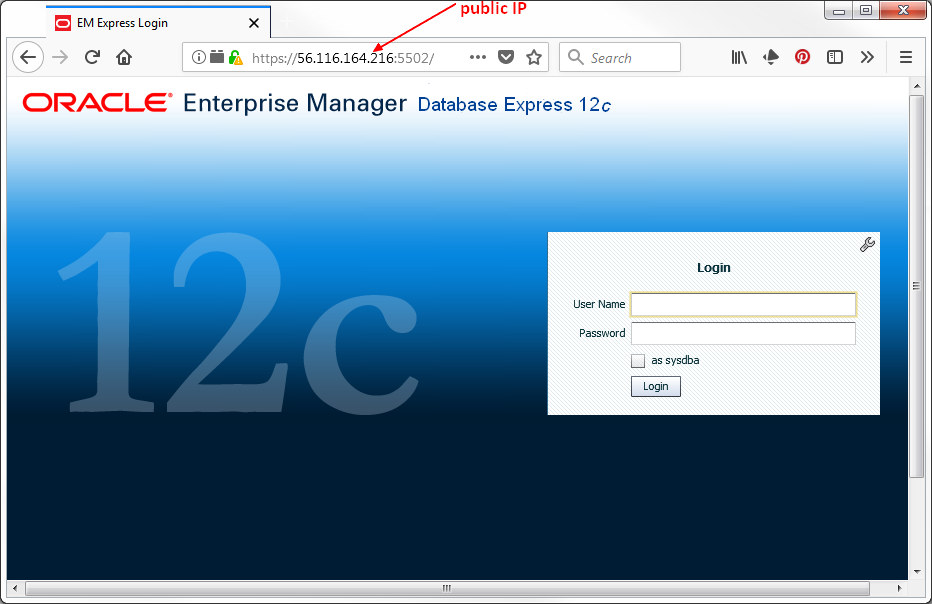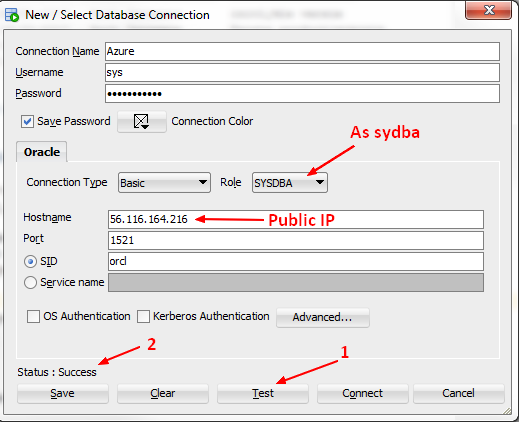Azure - Quick Oracle Database Installation from MarketPlace
About
Adapted from Create an Oracle Database in an Azure VM
Articles Related
Steps
Create the VM
With the azure cli
- without ssh key but authentication
az.cmd vm create ^
--resource-group myGROUP ^
--name HI-ORACLE-DB-02 ^
--image Oracle:Oracle-Database-Ee:12.1.0.2:latest ^
--size Standard_DS1_v2 ^
--authentication-type password ^
--admin-username adm ^
--admin-password ww ^
--location westeurope
{/ Finished ..
"fqdns": "",
"id": "/subscriptions/a3c34725-da6a-41ac-87fa-090f6b96d44d/resourceGroups/VGZ_OBIEE/prov
"location": "westeurope",
"macAddress": "00-0D-3A-23-BF-B0",
"powerState": "VM running",
"privateIpAddress": "10.0.0.5",
"publicIpAddress": "52.143.164.216",
"resourceGroup": "myGROUP",
"zones": ""
}
With the Market place GUI
After a quick search, you can select the image that you want and follow the wizard.
Connect to the VM
ssh [email protected]
Personally, I connect with WinScp and start a putty session from there (Ctrl + P).
As Oracle
sudo su - oracle
We trust you have received the usual lecture from the local System
Administrator. It usually boils down to these three things:
#1) Respect the privacy of others.
#2) Think before you type.
#3) With great power comes great responsibility.
[sudo] password for adm:
Start the listener
lsnrctl start
LSNRCTL for Linux: Version 12.1.0.2.0 - Production on 09-JAN-2018 01:30:41
Copyright (c) 1991, 2014, Oracle. All rights reserved.
Starting /u01/app/oracle/product/12.1.0/dbhome_1/bin/tnslsnr: please wait...
TNSLSNR for Linux: Version 12.1.0.2.0 - Production
Log messages written to /u01/app/oracle/diag/tnslsnr/HI-ORACLE-DB-02/listener/alert/log.xml
Listening on: (DESCRIPTION=(ADDRESS=(PROTOCOL=tcp)(HOST=HI-ORACLE-DB-02.13wobvhsfboenhxe1vn1ey30oe.ax.internal.cloudapp.net)(PORT=1521)))
Connecting to (ADDRESS=(PROTOCOL=tcp)(HOST=)(PORT=1521))
STATUS of the LISTENER
------------------------
Alias LISTENER
Version TNSLSNR for Linux: Version 12.1.0.2.0 - Production
Start Date 09-JAN-2018 01:30:42
Uptime 0 days 0 hr. 0 min. 1 sec
Trace Level off
Security ON: Local OS Authentication
SNMP OFF
Listener Log File /u01/app/oracle/diag/tnslsnr/HI-ORACLE-DB-02/listener/alert/log.xml
Listening Endpoints Summary...
(DESCRIPTION=(ADDRESS=(PROTOCOL=tcp)(HOST=HI-ORACLE-DB-02.13wobvhsfboenhxe1vn1ey30oe.ax.internal.cloudapp.net)(PORT=1521)))
The listener supports no services
The command completed successfully
Create the database
dbca -silent \
-createDatabase \
-templateName General_Purpose.dbc \
-gdbname orcl \
-sid orcl \
-responseFile NO_VALUE \
-characterSet AL32UTF8 \
-sysPassword OraPasswd1 \
-systemPassword OraPasswd1 \
-createAsContainerDatabase false \
-databaseType MULTIPURPOSE \
-automaticMemoryManagement true \
-storageType FS \
-ignorePreReqs
Copying database files
1% complete
3% complete
11% complete
18% complete
26% complete
37% complete
Creating and starting Oracle instance
40% complete
45% complete
50% complete
55% complete
56% complete
60% complete
62% complete
Completing Database Creation
66% complete
70% complete
73% complete
85% complete
96% complete
100% complete
Look at the log file "/u01/app/oracle/cfgtoollogs/dbca/orcl/orcl.log" for further details.
Environment variable
vi ~/.bashrc
# ORACLE_HOME is already present
export ORACLE_HOME=/u01/app/oracle/product/12.1.0/dbhome_1
# Add ORACLE_SID.
export ORACLE_SID=orcl
Oracle express em
. ~/.bash_profile
sqlplus / as sysdba
SQL*Plus: Release 12.1.0.2.0 Production on Tue Jan 9 01:55:36 2018
Copyright (c) 1982, 2014, Oracle. All rights reserved.
Connected to:
Oracle Database 12c Enterprise Edition Release 12.1.0.2.0 - 64bit Production
With the Partitioning, OLAP, Advanced Analytics and Real Application Testing options
SQL> exec DBMS_XDB_CONFIG.SETHTTPSPORT(5502);
PL/SQL procedure successfully completed.
SQL> quit
Disconnected from Oracle Database 12c Enterprise Edition Release 12.1.0.2.0 - 64bit Production
With the Partitioning, OLAP, Advanced Analytics and Real Application Testing options
exec DBMS_XDB_CONFIG.SETHTTPSPORT(5502);
quit
# return to adm
exit
As root
Automate database startup and shutdown
- Connect as root
sudo su -
- change N as Y at the end of the oratab line
vi /etc/oratab
# /etc/oratab
orcl:/u01/app/oracle/product/12.1.0/dbhome_1:Y
- Create the dbora file with the following content
vi /etc/init.d/dbora
#!/bin/sh
# chkconfig: 345 99 10
# Description: Oracle auto start-stop script.
#
# Set ORA_HOME to be equivalent to $ORACLE_HOME.
ORA_HOME=/u01/app/oracle/product/12.1.0/dbhome_1
ORA_OWNER=oracle
case "$1" in
'start')
# Start the Oracle databases:
# The following command assumes that the Oracle sign-in
# will not prompt the user for any values.
# Remove "&" if you don't want startup as a background process.
su - $ORA_OWNER -c "$ORA_HOME/bin/dbstart $ORA_HOME" &
touch /var/lock/subsys/dbora
;;
'stop')
# Stop the Oracle databases:
# The following command assumes that the Oracle sign-in
# will not prompt the user for any values.
su - $ORA_OWNER -c "$ORA_HOME/bin/dbshut $ORA_HOME" &
rm -f /var/lock/subsys/dbora
;;
esac
- Change its permission
chgrp dba /etc/init.d/dbora
chmod 750 /etc/init.d/dbora
- Create symlink for startup
ln -s /etc/init.d/dbora /etc/rc.d/rc0.d/K01dbora
ln -s /etc/init.d/dbora /etc/rc.d/rc3.d/S99dbora
ln -s /etc/init.d/dbora /etc/rc.d/rc5.d/S99dbora
Network
- Allow Oracle Port. Example to restrict the access of the port 1521 to a public IP defined in the –source-address-prefixes options
az.cmd network nsg rule create ^
--resource-group myResourceGroup ^
--nsg-name myVmNSG ^
--name allow-oracle ^
--protocol tcp ^
--priority 1001 ^
--destination-port-range 1521 ^
--source-address-prefixes 193.172.53.8
- Allow Em Port. Example to restrict the access of the port 5502 to a public IP defined in the –source-address-prefixes options
az.cmd network nsg rule create ^
--resource-group myResourceGroup ^
--nsg-name myVmNSG ^
--name allow-em ^
--protocol tcp ^
--priority 1002 ^
--destination-port-range 5502 ^
--source-address-prefixes 193.172.53.8
Test
- Em (https://publicIp:5502/em) and allows flash :(
- Sql Developer



